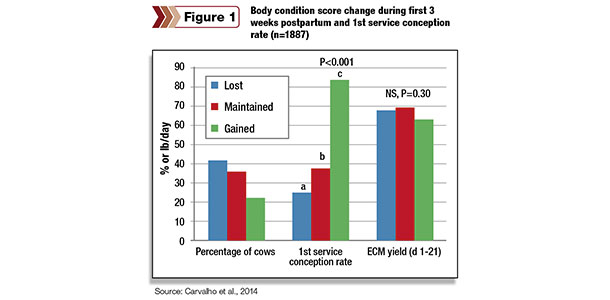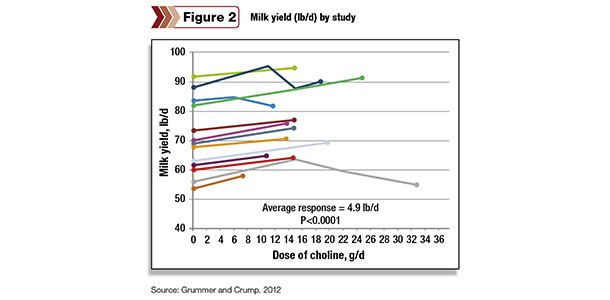Nutrition in the postfresh pen may be the true determination of a successful lactation. Often referred to as the most critical time in a cow’s life, the transition period sets the stage for milk production, reproduction and overall health. While this time frame extends three weeks on either side of calving, the majority of research has focused on the nutritional demands of the prefresh cow.
However, Ric Grummer, Ph.D., ruminant technical director at Balchem Corp, believes it is time to pay attention to the postfresh cow’s needs.
“I really think, in most situations, it is perhaps the postfresh period that is more important,” Grummer stated during the Land O’Lakes Leading Dairy Producer Conference held in Wisconsin Dells, Wisconsin, January 15-16.
Grummer discussed new research regarding postfresh cow protein, energy and choline demands, and how satisfying these nutrient needs can potentially result in more milk and faster breedbacks.
Are you losing milk to a ‘protein deficit?’
As a cow comes into her lactation, demands for crude protein, metabolizable protein and amino acids run high, while dry matter intake struggles to keep pace. In many cases, these cows are in a “protein deficit,” said Grummer.
Even when fed the 180 g per day recommended by the National Research Council (NRC), high-producing cows in particular could be falling short of the metabolizable protein they need.
When not supplied in her diet, she turns to mobilizing protein reserves. One Danish study showed that cows may mobilize 10 pounds of essential amino acids in the first month of lactation.
The same study went on to show that increasing metabolizable protein fed to postfresh cows boosted milk production by 16 pounds per day (80.6 versus 95.6).
“We took off the ‘handcuffs’,” added Grummer. “We took away one of the limitations by giving the cow more metabolizable protein.”
The cows in the study did not increase feed intake for more energy; instead, they mobilized more fat off of their backs.
While there is more research to be done, Grummer emphasized the point that protein is critical for postfresh cows.
“We have pressures to scale back, but for postfresh cows, you’ve got to be careful,” warned Grummer. “That is not the period of time to be cheating the cows on protein.”
The postfresh pen gives producers a 21-day window to supplement these protein-deficient cows with feeds high in bypass protein as well as protected amino acids.
Negative energy balance and reproduction
Postfresh cows are likely to experience a negative energy balance, resulting in a loss of body condition. New research shows that this can wreak havoc on reproduction.
Data from a recently presented University of Wisconsin – Madison thesis suggested significant improvements in first-service conception rates among cows that maintained or gained body condition between calving and three weeks postfresh ( Figure 1 ).

This information came from two large commercial dairies. Slightly more than 40 percent of the cows observed lost body condition, while nearly 60 percent maintained or gained. Those that lost or maintained sat at a first-service conception rate of 35 percent; however, more than 80 percent of the cows that had gained body condition bred back on the first shot.
Looking at milk production across these three groups, there was no difference; the cows that gained were still producing just as much milk. These cows were getting their energy from eating, pointed out Grummer. The energy balance was not related to milk production but rather energy intake.
He stated, “We need to get energy into those cows, and we need to get [it in] the first three weeks postcalving.”
One way to increase energy fed to postfresh cows is by increasing starch in the diet. Not only does this up the energy density, but it increases energy intake and milk yield with less mobilization of body fat. The downfall is a potentially negative effect on feed intake, which may lead to acidosis or displaced abomasum.
Grummer defined 25 percent starch as reasonable for the postfresh cow ration. However, increases in starch feeding should be accompanied by monitoring evidence for acidosis and DA.
Forages may also help to fill the energy void, particularly highly digestible forages.
Managing fat mobilization with choline
All cows go through some mobilization of fat after calving, and half will have a moderate to severe case of fatty liver. Choline is essential for this naturally occurring process, helping to transport fat out of the liver.
The primary symptom of fatty liver is choline deficiency, which led Grummer to review several studies that looked at supplementing rumen-protected choline to transition cows. While there were no significant differences observed prepartum, postpartum feed intake increased by 1.6 pounds per day and milk production by 4.9 pounds per day ( Figure 2 ).
 “When you look at all of these studies together, it is pretty convincing that there is an increase in milk production,” Grummer said.
“When you look at all of these studies together, it is pretty convincing that there is an increase in milk production,” Grummer said.
In fact, he foresees further validation of greater choline requirements.
“With the alleviation of the classic deficiency symptom and the milk responses we are seeing, we do think [choline] is a required nutrient, and we hope that will be included in the next NRC requirements,” he added.
Other possible benefits noted in the studies were less incidence of ketosis and lower somatic cell count.
Grummer recommended feeding 15 grams per day of rumen-protected choline, or 60 grams per day of an encapsulated product. Preferably, all cows should receive the supplement 21 days before and after calving.
He went on to emphasize the importance of prefresh and postfresh pens to accommodate the nutritional needs during the transition period.
“Between the protein story, the energy story and the choline story, these girls are unique,” Grummer said, “and you need to treat them uniquely during those last three weeks prefresh and those first three weeks postfresh.” PD

Peggy Coffeen
Editor
Progressive Dairyman






